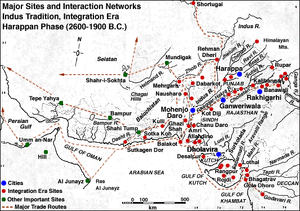Sutkagan Dor
| Author:Laxman Burdak, IFS (R) |

Sutkagan Dor (or Sutkagen Dor) (सुत्कागेन दोड़) is the westernmost known archaeological site of the Indus Valley Civilization.
Location
It is located about 480 km west of Karachi on the Makran coast, near the Iranian border, in Pakistan's Baluchistan Province. The site is near the western bank of the Dasht River and its confluence with a smaller stream, known as the Gajo Kaur.
Excavations
It was a smaller settlement with substantial stone walls and gateways.[1]
Sutkagan Dor was discovered in 1875 by Major Edward Mockler, who conducted small-scale excavation.
In 1928 Aurel Stein visited the area as part of his Gedrosia tour, and carried out further digs. In October 1960, Sutkagan Dor was more extensively excavated by George F. Dales as a part of his Makran Survey,[2] uncovering structures made from stone and mud bricks without straw.
Coastal route
Though inland at present, the site may have been near navigable water in ancient times, on a trade route between other centers. A coastal route existed linking sites such as Lothal and Dholavira to Sutkagan Dor on the Makran coast.[3] It has been suggested that the site may well have been an important trading post, connecting seaborne trade from the Persian Gulf and the Arabian Sea to the hinterland.[4]
References
- ↑ McIntosh, Jane R. (2008). The Ancient Indus Valley : New Perspectives. Santa Barbara, Calif.: ABC-CLIO. p. 169. ISBN 9781576079072.
- ↑ Possehl, Gregory L. (2003). The Indus Civilization : A Contemporary perspective ([3rd printing]. ed.). New Delhi: Vistaar Publications. pp. 79–80. ISBN 8178292912.
- ↑ Singh, Upinder (2008). A History of Ancient and Early Medieval India : from the Stone Age to the 12th century. New Delhi: Pearson Education. p. 167. ISBN 9788131711200.
- ↑ Singh, Sarva Daman (1968). Ancient Indian Warfare With Special Reference To The Vedic Period. Brill Archive. p. 122.
Back to Indus Valley Civilization

